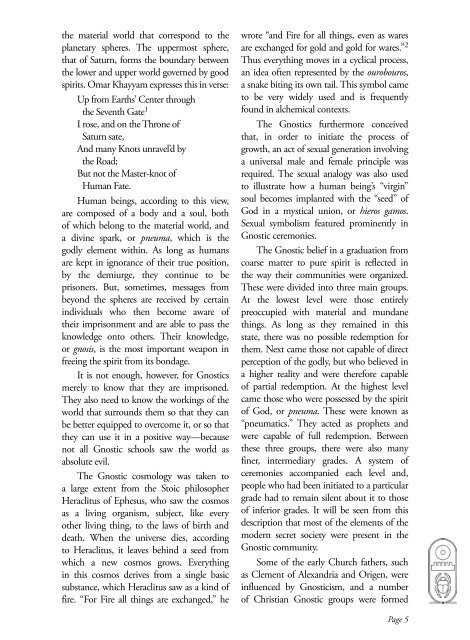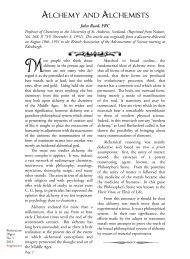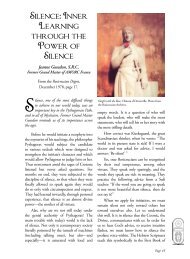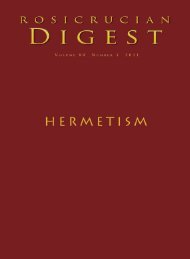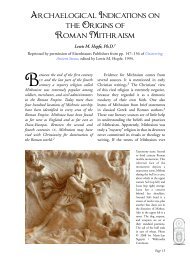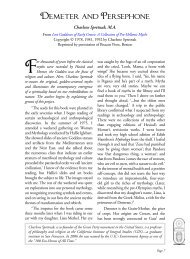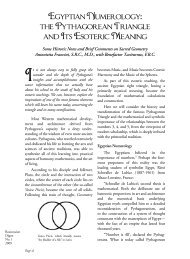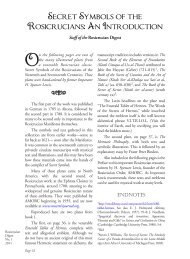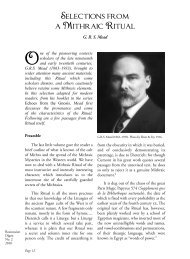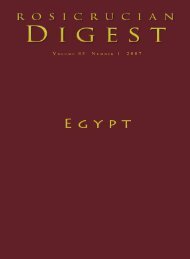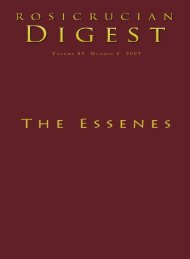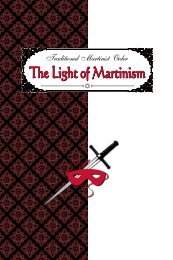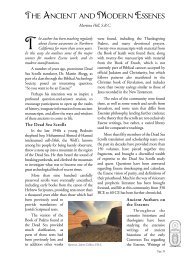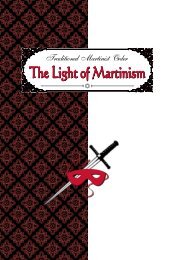Rosicrucian Digest Vol 89 No 2 2011 Gnosticism - Rosicrucian Order
Rosicrucian Digest Vol 89 No 2 2011 Gnosticism - Rosicrucian Order
Rosicrucian Digest Vol 89 No 2 2011 Gnosticism - Rosicrucian Order
You also want an ePaper? Increase the reach of your titles
YUMPU automatically turns print PDFs into web optimized ePapers that Google loves.
the material world that correspond to the<br />
planetary spheres. The uppermost sphere,<br />
that of Saturn, forms the boundary between<br />
the lower and upper world governed by good<br />
spirits. Omar Khayyam expresses this in verse:<br />
Up from Earths’ Center through<br />
the Seventh Gate 1<br />
I rose, and on the Throne of<br />
Saturn sate,<br />
And many Knots unravel’d by<br />
the Road;<br />
But not the Master-knot of<br />
Human Fate.<br />
Human beings, according to this view,<br />
are composed of a body and a soul, both<br />
of which belong to the material world, and<br />
a divine spark, or pneuma, which is the<br />
godly element within. As long as humans<br />
are kept in ignorance of their true position,<br />
by the demiurge, they continue to be<br />
prisoners. But, sometimes, messages from<br />
beyond the spheres are received by certain<br />
individuals who then become aware of<br />
their imprisonment and are able to pass the<br />
knowledge onto others. Their knowledge,<br />
or gnosis, is the most important weapon in<br />
freeing the spirit from its bondage.<br />
It is not enough, however, for Gnostics<br />
merely to know that they are imprisoned.<br />
They also need to know the workings of the<br />
world that surrounds them so that they can<br />
be better equipped to overcome it, or so that<br />
they can use it in a positive way—because<br />
not all Gnostic schools saw the world as<br />
absolute evil.<br />
The Gnostic cosmology was taken to<br />
a large extent from the Stoic philosopher<br />
Heraclitus of Ephesus, who saw the cosmos<br />
as a living organism, subject, like every<br />
other living thing, to the laws of birth and<br />
death. When the universe dies, according<br />
to Heraclitus, it leaves behind a seed from<br />
which a new cosmos grows. Everything<br />
in this cosmos derives from a single basic<br />
substance, which Heraclitus saw as a kind of<br />
fire. “For Fire all things are exchanged,” he<br />
wrote “and Fire for all things, even as wares<br />
are exchanged for gold and gold for wares.” 2<br />
Thus everything moves in a cyclical process,<br />
an idea often represented by the ourobouros,<br />
a snake biting its own tail. This symbol came<br />
to be very widely used and is frequently<br />
found in alchemical contexts.<br />
The Gnostics furthermore conceived<br />
that, in order to initiate the process of<br />
growth, an act of sexual generation involving<br />
a universal male and female principle was<br />
required. The sexual analogy was also used<br />
to illustrate how a human being’s “virgin”<br />
soul becomes implanted with the “seed” of<br />
God in a mystical union, or hieros gamos.<br />
Sexual symbolism featured prominently in<br />
Gnostic ceremonies.<br />
The Gnostic belief in a graduation from<br />
coarse matter to pure spirit is reflected in<br />
the way their communities were organized.<br />
These were divided into three main groups.<br />
At the lowest level were those entirely<br />
preoccupied with material and mundane<br />
things. As long as they remained in this<br />
state, there was no possible redemption for<br />
them. Next came those not capable of direct<br />
perception of the godly, but who believed in<br />
a higher reality and were therefore capable<br />
of partial redemption. At the highest level<br />
came those who were possessed by the spirit<br />
of God, or pneuma. These were known as<br />
“pneumatics.” They acted as prophets and<br />
were capable of full redemption. Between<br />
these three groups, there were also many<br />
finer, intermediary grades. A system of<br />
ceremonies accompanied each level and,<br />
people who had been initiated to a particular<br />
grade had to remain silent about it to those<br />
of inferior grades. It will be seen from this<br />
description that most of the elements of the<br />
modern secret society were present in the<br />
Gnostic community.<br />
Some of the early Church fathers, such<br />
as Clement of Alexandria and Origen, were<br />
influenced by <strong>Gnosticism</strong>, and a number<br />
of Christian Gnostic groups were formed<br />
Page 5


